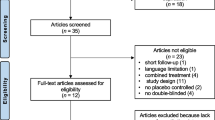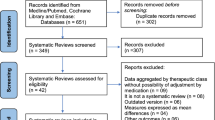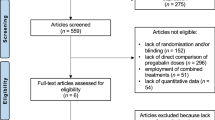Abstract
Fibromyalgia is characterized by widespread pain, sleep problems, fatigue, functional impairment, psychological distress, and cognitive dysfunction. The objective of this meta-analysis is to synthesize the available data on the effectiveness of pharmacological and non-pharmacological interventions across all domains included in the Outcome Measures in Rheumatology Clinical Trials (OMERACT-10) fibromyalgia response definitions, and to examine response based on these definitions. We searched Cochrane, PubMed, Scopus, and the reference lists of articles for randomized controlled trials of any drug formulation or non-pharmacological intervention used for fibromyalgia treatment. We extracted efficacy data regarding pain, sleep, physical function, fatigue, anxiety, depression, and cognition. The available data were insufficient to draw definite conclusions regarding response. Indirect evidence indicates that it may be expected with the use of serotonin noradrenaline reuptake inhibitors (SNRIs), noradrenaline reuptake inhibitors (NRIs), and multidisciplinary treatment.






Similar content being viewed by others
References
Luedtke CA, Thompson JM, Postier JA, Neubauer BL, Drach S, Newell L (2005) A description of a brief multidisciplinary treatment program for fibromyalgia. Pain Manag Nurs 6(2):76–80
Wolfe F, Smythe HA, Yunus MB, Bennett RM, Bombardier C, Goldenberg DL et al (1990) The American College of Rheumatology 1990 Criteria for the classification of fibromyalgia. Report of the Multicenter Criteria Committee. Arthritis Rheum 33(2):160–172
Bennett R, Friend R, Marcus D, Bernstein C, Han BK, Yachoui R et al (2014) Criteria for the diagnosis of fibromyalgia: validation of the modified 2010 preliminary American College of Rheumatology criteria and the development of alternative criteria. Arthritis Care Res 66(9):1364–1373
Lawson K (2007) Are complex therapies required as pharmacological treatments of fibromyalgia? Futur Rheumatol 2(6):599–605
Mease P, Arnold LM, Choy EH, Clauw DJ, Crofford LJ, Glass JM et al (2009) Fibromyalgia syndrome module at OMERACT 9: domain construct. J Rheumatol 36(10):2318–2329
Mease PJ, Clauw DJ, Christensen R, Crofford LJ, Gendreau RM, Martin SA (2011) Toward development of a fibromyalgia responder index and disease activity score: OMERACT module update. J Rheumatol 38(7):1487–1495
Arnold LM, Williams DA, Hudson JI, Martin SA, Clauw DJ, Crofford LJ et al (2012) Development of responder definitions for fibromyalgia clinical trials. Arthritis Rheum 64(3):885–894
Tofferi JK, Jackson JL, O’Malley PG (2004) Treatment of fibromyalgia with cyclobenzaprine: a meta-analysis. Arthritis Rheum 51(1):9–13
Häuser W, Wolfe F, Tölle T, Uçeyler N, Sommer C (2012) The role of antidepressants in the management of fibromyalgia syndrome: a systematic review and meta-analysis. CNS Drugs 26(4):297–307
Choy E, Marshall D, Gabriel ZL, Mitchell SA, Gylee E, Dakin HA (2011) A systematic review and mixed treatment comparison of the efficacy of pharmacological treatments for fibromyalgia. Semin Arthritis Rheum 41:335–345
Nüesch E, Häuser W, Bernardy K, Barth J, Jüni P (2013) Comparative efficacy of pharmacological and non-pharmacological interventions in fibromyalgia syndrome: network meta-analysis. Ann Rheum Dis 72(6):955–962
Rossy LA, Buckelew SP, Dorr N, Hagglund KJ, Thayer JF, McIntosh MJ, Hewett JE, Johnson JC (1999) A meta-analysis of fibromyalgia treatment interventions. Ann Behav Med 21(2):180–191
Liberati A, Altman DG, Tetzlaff J, Mulrow C, Gøtzsche PC, Ioannidis JP et al (2009) The PRISMA statement for reporting systematic reviews and meta-analyses of studies that evaluate health care interventions: explanation and elaboration. BMJ 339:b2700
Jadad AR, Moore RA, Carroll D, Jenkinson C, Reynolds DJ, Gavaghan DJ et al (1996) Assessing the quality of reports of randomized clinical trials: is blinding necessary? Control Clin Trials 17:1–12
Lundh A, Gøtzsche PC (2008) Recommendations by Cochrane Review Groups for assessment of the risk of bias in studies. BMC Med Res Methodol 8:22
Dixon KE, Keefe FJ, Scipio CD, Perri LM, Abernethy AP (2007) Psychological interventions for arthritis pain management in adults: a meta-analysis. Health Psychol 26(3):241–250
Berger VW (2006) Is the Jadad score the proper evaluation of trials? J Rheumatol 33:1710–1712
Bhogal SK, Teasell RW, Foley NC, Speechley MR (2005) The PEDro scale provides a more comprehensive measure of methodological quality than the Jadad scale in stroke rehabilitation literature. J Clin Epidemiol 58(7):668–673
Foley NC, Teasell RW, Bhogal SK, Speechley MR (2003) Stroke rehabilitation evidence-based review: methodology. Top Stroke Rehabil 10:1–7
Straus SE, Chesney MA (2006) Science and government. Enhanced: in defense of NCCAM. Science 313:303–304
Choy EH (2010) Clinical domains of fibromyalgia syndrome: determination through the OMERACT process. J Musculoskelet Pain 18(4):380–386
McGough JJ, Faraone SV (2009) Estimating the size of treatment effects moving beyond p values. Psychiatry (Edgmont) 6(10):21–29
Cohen J (1988) Statistical power analysis for the behavioral sciences. Eribaum, Hillsdale
Fu R, Vandermeer BJ, Shamliyan TA, O’Neil ME, Yazdi F, Fox SH et al (2008) Handling continuous outcomes in quantitative synthesis. Methods Guide for Effectiveness and Comparative Effectiveness Reviews. Cover of Methods Guide for Effectiveness and Comparative Effectiveness Reviews. Rockville (MD): Agency for Healthcare Research and Quality (US)
Higgins JP, Thompson SG, Deeks JJ et al (2003) Measuring inconsistency in meta-analyses. BMJ 327:557–560
Sanada K, Díez MA, Valero MS, Pérez-Yus MC, Demarzo MM, García-Toro M et al (2015) Effects of non-pharmacological interventions on inflammatory biomarker expression in patients with fibromyalgia: a systematic review. Arthritis Res Ther 17:272
Moses LE, Mosteller F, Buehler JH (2002) Comparing results of large clinical trials to those of meta-analyses. Stat Med 21:793–800
Acknowledgments
The authors would like to thank Anastasios Boutsiadis for his support and assistance in the statistical analysis.
Author information
Authors and Affiliations
Corresponding author
Ethics declarations
Disclosures
None.
Electronic supplementary material
Below is the link to the electronic supplementary material.
ESM 1
(DOCX 36 kb)
Rights and permissions
About this article
Cite this article
Papadopoulou, D., Fassoulaki, A., Tsoulas, C. et al. A meta-analysis to determine the effect of pharmacological and non-pharmacological treatments on fibromyalgia symptoms comprising OMERACT-10 response criteria. Clin Rheumatol 35, 573–586 (2016). https://doi.org/10.1007/s10067-015-3144-2
Received:
Revised:
Accepted:
Published:
Issue Date:
DOI: https://doi.org/10.1007/s10067-015-3144-2




